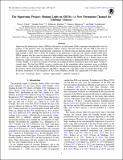The Supersonic Project: Shining Light on SIGOs—A New Formation Channel for Globular Clusters
Author(s)
Chiou, Yeou S; Naoz, Smadar; Burkhart, Blakesley; Marinacci, Federico; Vogelsberger, Mark
DownloadPublished version (1.844Mb)
Publisher Policy
Publisher Policy
Article is made available in accordance with the publisher's policy and may be subject to US copyright law. Please refer to the publisher's site for terms of use.
Terms of use
Metadata
Show full item recordAbstract
© 2019. The American Astronomical Society. All rights reserved. Supersonically induced gas objects (SIGOs) with little to no dark matter (DM) component are predicted to exist in patches of the universe with non-negligible relative velocity between baryons and the DM at the time of recombination. Using arepo hydrodynamic simulations we find that the gas densities inside of these objects are high enough to allow stars to form. An estimate of the luminosity of the first star clusters formed within these SIGOs suggests that they may be observed at high redshift using future Hubble Space Telescope and James Webb Space Telescope observations. Furthermore, our simulations indicate that SIGOs lie in a distinct place in the luminosity-radius parameter space, which can be used observationally to distinguish SIGOs from DM hosting gas systems. Finally, as a proof-of-concept, we model star formation before reionization and evolve these systems to current times. We find that SIGOs occupy a similar part of the magnitude-radius parameter space as globular clusters (GCs). These results suggest that SIGOs may be linked with present-day metal-poor local GCs. Because the relative velocity between the baryons and DM is coherent over a few Mpc scales, we predict that if this is the dominant mechanism for the formation of GCs, their abundance should vary significantly over these scales.
Date issued
2019Department
Massachusetts Institute of Technology. Department of Physics; MIT Kavli Institute for Astrophysics and Space ResearchJournal
Astrophysical Journal Letters
Publisher
American Astronomical Society